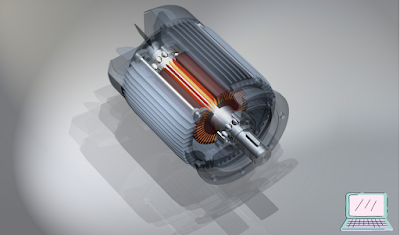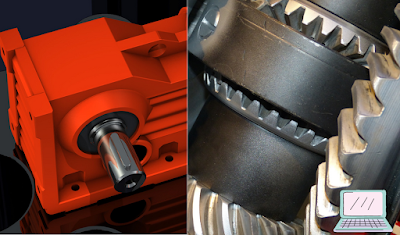electric motors
An electric motor is an electrical machine that converts electrical energy into mechanical energy. Most electric motors work by the interaction between the magnetic field of the motor and the current in the winding wire, creating a force in the form of a torque applied to the motor shaft. powered by DC sources such as batteries or rectifiers, or AC sources such as mains, inverters or generators. conversion of mechanical energy into electrical energy. Electric motors can be classified according to characteristics such as type of power supply, internal design, application and type.In addition to AC and DC motors, motors can be brushed or brushless, can be multi-phase, and can be air or liquid cooled. Electric motors are used in industrial fans, blowers and pumps, machine tools, appliances, power tools and drives. Small motors can be found in electricity meters. Of courseIn applications such as traction regenerative braking, the electric motor can be used in the opposite direction as a generator to recover energy that would otherwise be lost in the form of heat and friction. Magnetic solenoids are also converters of electrical energy into mechanical movement, but they can only cause movement over a limited distance. much more efficient than other main engines used in industry and transport, internal combustion engines; Electric motors are often shorted more than 95% and ICEs less than 50%.They are also lighter in weight, physically smaller, mechanically easier to assemble and cheaper, they can provide instant and constant torque at any speed, they have electric vehicles that are generated from renewable sources, and they do not emit carbon into the atmosphere. For these reasons, electric motors are replacing internal combustion engines in transportation and industry, although their use in vehicles is currently limited by their high cost and weight. Batteries can provide sufficient range between charges.In 1820, Hans Christian Oersted discovered that an electric current creates a magnetic field that can act on a magnet. It took André Marie Ampere only a few weeks to develop the first formula for electromagnetic interaction and came up with Ampere's law of force, which describes the occurrence of mechanical force due to the interaction of electric currents and magnetic fields. Michael Faraday first demonstrated the spinning effect in 1821. When an electric current was passed through the wire, the wire was spun around the magnet, indicating that the current was creating a circular magnetic field around the wire.This motif is often demonstrated in physics experiments where salt water is replaced by mercury. The Barlow wheel was an early improvement on this Faraday proof, although these and similar parallel pole motors remained unusable until the end of this century. In 1827, Hungarian physicist Anjos Jedlik began experiments with electromagnetic coils. After Jedlik solved the technical problems of continuous rotation with his invention of the commutator, he called his first devices "electromagnetic automata." DC motor:
How it works
It creates a magnetic field that passes through the rotating armature, which affects the windings. The stator core consists of many thin metal plates electrically insulated from each other and are called laminar. Sealed motors used in washing machines and air conditioners use the damping properties of rosin to reduce noise and vibration. These motors completely cover the stator with plastic. Magnetic core to form magnetic poles when powered by current. Electrical machines have two basic configurations of magnetic poles: direct and zero. A sub-axis in a non-polar field, distributor or circular rotating machine, the magnetic core does not have a front pole, but a smooth cylinder with coils evenly distributed in grooves around the circumference. The direction of the alternating current in the coils creates continuously circular electrodes in the core A. Some motors have conductors made of thicker metals, such as metal rods or plates, usually copper or aluminum. It is usually driven by electromagnetic induction. Some motors supply current to the rotor. It consists of a cylinder made up of many metal contacts in the rotating motor of the machine. Two or more electrical contacts, called a "brush," are made of a soft, conductive material such as carbon, which is pressed against a switch, causing the contact to slide into successive parts. It is operated through the split ring switch as shown above. General motors can run on both alternating current and direct current. DC motors for motor control can be started at variable speeds by adjusting the DC voltage applied to the terminals or by pulse-width modulation, and constant-speed AC motors are usually started either directly from the mains or from a soft starter motor. Variable speed AC motors are available in several inverter, inverter or electronic switching technologies. In an excited motor, a magnetic field is generated in both the rotor and the stator. torque on the motor shaft. One or both of these fields must change as the rotor is rotating. This is done by turning the electrodes on and off at the right time, or by changing the strength of the electrodes. The main types are AC and DC motors, the latter replacing the former. AC asynchronous or synchronous motor. Once started, the synchronous motor requires synchronization with the speed of the moving magnetic field for all conditions. In a synchronous machine, the magnetic field must be created by means other than induction, such as a separate excited coil or permanent magnet. Engine with a fractional power of about 1 hp. smaller or produced with a standard chassis smaller than the standard 1 HP engine.
DC motor
DC coil DC motor with winding DC motor Mixed motor: cumulative differential connection DC motor with separate excitation DC motor with permanent magnet One permanent magnet motor without top magnetic field, wound on the stator housing, but dependent on PM for providing an opposite magnetic field with which the rotor field interacts, creating a torque.Compensating windings in series with the armature can be used on larger motors to improve load switching. Since this field is fixed, it cannot be configured for speed control. The PM field is useful in miniature motors to eliminate the energy consumption of the field winding. DC motors - "generator", with stator windings. Historically, PMs have not been able to support high flow when disassembled; more practical field coils to obtain the required amount of magnetic flux. However, large PMs are very expensive. and also dangerous anddifficult to assemble; this facilitates the winding of fields for large machines. To minimize overall size and weight, miniature permanent magnet motors can use high-energy magnets made of neodymium or other strategic elements; Most of them are alloys of neodymium, iron and boron. With their higher magnetic flux density, high power PM machines can at least compete with all optimally designed single source induction and synchronous machines. and its outer shell is a steel tube that magnetically connects to the outside of the curved field magnet. Electronic Collector Motor Brushless DC Motor Some of the problems of brushed DC motors have been addressed in the BLDC design.The "switch" or commutator is replaced by an external electronic switch that is synchronized with the rotor position. BLDC motors typically have a shortening of 85-90 ° or more. Efficiency for BLDC motors has been achieved up to 96.5%. Report while this brush is decelerating Conventional DC Motor 75 - The characteristic inverted trapezoidal EMF waveform for BLDC motors is partly due to the even distribution of the stator windings and partly to the position of the permanent magnet of the covered rotor. The motor can be single-phase, two-phase.or three-phase and use Hall effect sensors mounted on their coils to detect rotor position and inexpensively control an electronic switch with feedback. , CDROM drives and mechanisms in office products such as fans, laser printers and copiers. They have several advantages over conventional motors: Compared to AC fans that use screened motors, they are very efficient and run much colder than comparable AC motors. As a result, the service life of the fan bearings is increased. Without a worn out commutator, the life of a BLDC motor can be significantly longer than that of a DC motor with brushes and commutators.Switching also tends to cause a lot of electrical and radio frequency interference; BLDC motors without commutator or brush can be used in electrically sensitive equipment such as audio equipment or computers. Analog Hall effect sensors that provide switching can also provide a convenient tacho signal for closed-loop control applications. In fans, the tachometer signal can be used to provide a “fan healthy” signal as well as to provide feedback on operating speed. The motor can be easily synchronized with an internal or external clock, providing precise speed control. to environments with volatile chemicals and fuels. In addition, sparks release ozone, which can accumulate in poorly ventilated buildings with the risk of damage.BLDC motors are commonly used in small devices like computers and are often used in fans to remove unwanted heat. They are also very quiet motors acoustically, which is an advantage when used in equipment subject to vibration. Modern BLDC motors range in power from fractions of a watt to many kilowatts. The largest BLDC motors up to about 100 kW are used in electric vehicles. They also find significant application in high-performance electric aircraft models. Permanent magnets and rotors have no current. Instead, the torque arises from the slight misalignment of the rotor poles with the stator poles.The rotor aligns with the stator magnetic field, while the stator magnetic field coils are sequentially energized to rotate the stator magnetic field.





No comments:
Post a Comment